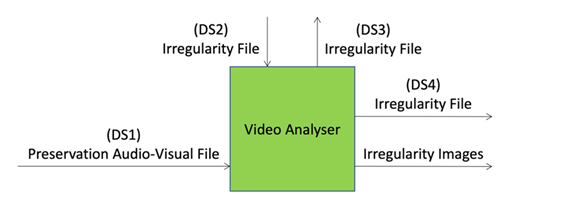| 1 Function | 2 Reference Model | 3 Input/Output Data |
| 4 SubAIMs | 5 JSON Metadata | 6 Profiles |
| 7 Reference Software | 8 Conformance Texting | 9 Performance Assessment |
1. Function
- Detects and enters the Video Irregularities of the Preservation Audio-Visual File in the Video Irregularity File.
- Sends Video Irregularity File to and receives Audio Irregularity Files from Audio Analysis for Preservation.
- Extracts the Images corresponding to the Irregularities of both Irregularity Files.
- Sends the Irregularity merged from the Audio and Video Irregularity Files to Tape Irregularity Classification with the corresponding Video Files.
2. Reference Model

Figure 1 – Video Analysis for Preservation AIM
3. Input/Output Data
| Input data | Semantics |
| Preservation Audio-Visual File | The input Audio File resulting from the digitisation of an audio open-reel tape to be preserved and, in case, restored. |
| Audio Irregularity File | A JSON file containing information about the Irregularities of the Preservation Audio File received from Audio Analysis for Preservation. |
| Video Irregularity File | A JSON file containing information about the Irregularities of the Preservation Audio-Visual File received from Video Analysis for Preservation. |
| Output data | Semantics |
| Video Irregularity File | A JSON file containing information about the Irregularities of the Preservation Audio-Visual File received from Video Analysis for Preservation. |
| Irregularity Images | Images corresponding to the Irregularities received or detected |
4. SubAIMs
No SubAIMs.
5. JSON Metadata
https://schemas.mpai.community/CAE1/V2.4/AIMs/VideoAnalysisForPreservation.json
6. Profiles
No Profiles
7. Reference Software
The CAE-VAP Reference Software can be downloaded from the MPAI Git.
8. Conformance Testing
| Receives | Preservation Audio-Visual File | Shall validate against the Audio-Visual Object schema. The Qualifier shall validate against the Audio-Visual Qualifier schema. The values of any Sub-Type, Format, and Attribute of the Qualifier shall correspond with the Sub-Type, Format, and Attributes of the Audio-Visual Object Qualifier schema. |
| Audio Irregularity File | Shall validate against the Visual Object schema. The Qualifier shall validate against the Audio Qualifier schema. The values of any Sub-Type, Format, and Attribute of the Qualifier shall correspond with the Sub-Type, Format, and Attributes of the Audio Object Qualifier schema. |
|
| Video Irregularity File | Shall validate against the Irregularity File schema. | |
| Produces | Video Irregularity File | Shall validate against the Irregularity File schema. |
| Irregularity Images | Shall validate against the Irregularity File schema. |
9. Performance Assessment
Table 26 gives the Audio Recording Preservation (ARP) Video Analyser Means and how they are used.
Table 26 – AIM Means and use of Audio Recording Preservation (ARP) Video Analyser.
| Means | Actions |
| Performance Assessment Dataset | DS1: n Preservation Audio-Visual Files.
DS2: n Irregularity Files related to the Preservation Audio File related to DS1. DS3: n output Irregularity Files in the format of port IrregularityFileOutput_1 with all Irregularities correctly identified. DS4: n output Irregularity Files in the format of port IrregularityFileOutput_2 with all Irregularities correctly identified and included from DS3. |
| Procedure | 1. Feed Video Analyser under Assessment with DS1 and DS2.
2. Analyse the Irregularity Files resulting from port IrregularityFileOutput_1. 3. Analyse the Irregularity Files resulting from port IrregularityFileOutput_2. |
| Evaluation | 1. Verify the conditions:
a. The Irregularity Files are syntactically correct and conforming to the JSON schema provided in CAE Technical Specification. b. All Irregularities from DS2 are included in the Irregularity Files resulting from port IrregularityFileOutput_2. c. All output Irregularity Images are conforming to the JPEG standard [8]. d. For each of the n tuples of input records, the output Irregularity Images are extracted from the corresponding input Preservation Audio-Visual File at the Time Labels indicated in the Irregularity Files coming from port IrregularityFileOutput_2. 2. By inspecting the Irregularity Files resulting from port IrregularityFileOutput_1, for each of the n tuples of input records, compute the values of Recall (R) and Precision (P). 3. Compute the average value of Recall ( ) and Precision ( ) measures obtained at point 2. 4. Accept the AIM under Assessment if: a. R’>0.9 b. P’>0.9 |

Figure 11 – Video Analyser.
After the Assessment, Performance Assessor shall fill out Table 27.
Table 27 – Performance Assessment form of Audio Recording Preservation (ARP) Video Analyser.
| Performance Assessor ID | Unique Performance Assessor Identifier assigned by MPAI | ||||||||||||
| Standard, Use Case ID and Version | Standard ID and Use Case ID, Version and Profile of the standard in the form “CAE-ARP-V2.4”. | ||||||||||||
| Name of AIM | Video Analyser | ||||||||||||
| Implementer ID | Unique Implementer Identifier assigned by MPAI Store. | ||||||||||||
| AIM Implementation Version | Unique Implementation Identifier assigned by Implementer. | ||||||||||||
| Neural Network Version* | Unique Neural Network Identifier assigned by Implementer. | ||||||||||||
| Identifier of Performance Assessment Dataset | Unique Dataset Identifier assigned by MPAI Store. | ||||||||||||
| Assessment ID | Unique Assessment Identifier assigned by Performance Assessor. | ||||||||||||
| Actual output | Actual output provided as a matrix of n rows containing and values.
|
||||||||||||
| Execution time* | Duration of Assessment execution. | ||||||||||||
| Assessment comment* | – | ||||||||||||
| Assessment Date | yyyy/mm/dd. |
* Optional field

